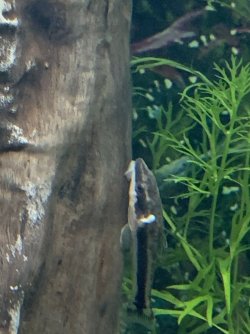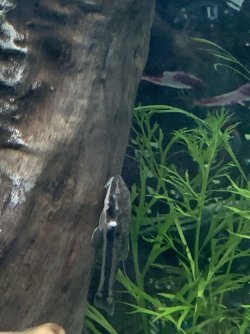You are using an out of date browser. It may not display this or other websites correctly.
You should upgrade or use an alternative browser.
You should upgrade or use an alternative browser.
Help.
- Thread starter dman67
- Start date
AbbeysDad
Fish Gatherer
I'm not sure what it is but ich is rarely a single white spot.
PlasticGalaxy
Fish Gatherer
Probably not ICH, as AbbeysDad said, it's usually not just one big splotch of white. But also not sure. Maybe just some shrapnel from the tank or something? Keep an eye on him. He's a cutie!
Will you please try to get more photos?
Seconding the request for more photos please! I know it's not easy to do, but we can't really help much without a clearer image of what it is...
It definitely is not white spot, I can tell you that much for sure.
Tips for aquarium photography - turn all the other room lights off and draw curtains if it's light out, no other lights on except for the aquarium light, so you don't get reflections in the glass when you take the photo.
If you can lure the fish out to a spot by using food, like perhaps some blanched courgette or cucumber at the front of the tank, it can be easier to focus the camera on that spot and snap away, but having otos myself, I know it's not an easy fish to lure out like that!
It definitely is not white spot, I can tell you that much for sure.
Tips for aquarium photography - turn all the other room lights off and draw curtains if it's light out, no other lights on except for the aquarium light, so you don't get reflections in the glass when you take the photo.
If you can lure the fish out to a spot by using food, like perhaps some blanched courgette or cucumber at the front of the tank, it can be easier to focus the camera on that spot and snap away, but having otos myself, I know it's not an easy fish to lure out like that!
dman67
New Member
Okay it initially looked like a large smooth white bump fully attached to the body know it is hanging off I can see it “waving” in the water. Here are more pictures but as my too refuse to eat anything I put in the tank luring him out is hard
Attachments
-
 E516DA0F-6D5E-4A16-9032-E1FFAA043CB6.jpeg241.3 KB · Views: 55
E516DA0F-6D5E-4A16-9032-E1FFAA043CB6.jpeg241.3 KB · Views: 55 -
 81B71607-D13F-423D-8C8D-391ED9313DB4.jpeg218.5 KB · Views: 49
81B71607-D13F-423D-8C8D-391ED9313DB4.jpeg218.5 KB · Views: 49 -
 5C7EFD97-3368-4224-8ECF-52EE974E58C5.jpeg222.1 KB · Views: 51
5C7EFD97-3368-4224-8ECF-52EE974E58C5.jpeg222.1 KB · Views: 51 -
 B784E317-C88F-4A76-B395-300130794D3C.jpeg238.5 KB · Views: 57
B784E317-C88F-4A76-B395-300130794D3C.jpeg238.5 KB · Views: 57 -
 043CB500-18C4-473B-BEC3-D15EAD58C5E2.jpeg222.2 KB · Views: 65
043CB500-18C4-473B-BEC3-D15EAD58C5E2.jpeg222.2 KB · Views: 65 -
 B1D45E09-760F-4DA0-8AD3-C2154E130B8B.jpeg224.1 KB · Views: 57
B1D45E09-760F-4DA0-8AD3-C2154E130B8B.jpeg224.1 KB · Views: 57 -
 775FD437-4A2D-4F6E-9488-EA587DBB3219.jpeg236.5 KB · Views: 49
775FD437-4A2D-4F6E-9488-EA587DBB3219.jpeg236.5 KB · Views: 49
dman67
New Member
dman67
New Member
I have a quarantine tank but don’t want to move him there unnecessarily as my 3 oto ably eat algae (not wafers) and there is no algae in that tank. If he stays there long he will starve. Right now he is behaving normally active and eating. Nothing visibly wrong with other fish in the tank
Looks like a wound.
Do a 75% water change and gravel clean substrate every day for a week.
Make sure new water is free of chlorine/ chloramine before it's added to the tank.
Clean the filter if it hasn't been done in the last 2 weeks. However, if the filter is less than 6 weeks old, do not clean it. Wash the filter materials/ media in a bucket of tank water and re-use them. Tip the bucket of dirty water on the garden/ lawn. Cleaning the filter means less gunk and cleaner water with fewer pathogens.
Increase surface turbulence/ aeration when using salt or medications because they reduce the dissolved oxygen in the water.
Add some salt, (see directions below).
-------------------
SALT
You can add rock salt (often sold as aquarium salt) or swimming pool salt to the aquarium at the dose rate of 1 heaped tablespoon per 20 litres of water. If there is no improvement after 48 hours you can double that dose rate so there is 2 heaped tablespoons of salt per 20 litres.
If you only have livebearers (guppies, platies, swordtails, mollies), goldfish or rainbowfish in the tank you can double that dose rate, so you would add 2 heaped tablespoons per 20 litres and if there is no improvement after 48 hours, then increase it so there is a total of 4 heaped tablespoons of salt per 20 litres.
Keep the salt level like this for at least 2 weeks but no longer than 4 weeks otherwise kidney damage can occur. Kidney damage is more likely to occur in fish from soft water (tetras, Corydoras, angelfish, Bettas & gouramis, loaches) that are exposed to high levels of salt for an extended period of time, and is not an issue with livebearers, rainbowfish or other salt tolerant species.
The salt will not affect the beneficial filter bacteria but the higher dose rate (4 heaped tablespoons per 20 litres) will affect some plants and some snails. The lower dose rate (1-2 heaped tablespoons per 20 litres) will not affect fish, plants, shrimp or snails.
After you use salt and the fish have recovered, you do a 10% water change each day for a week using only fresh water that has been dechlorinated. Then do a 20% water change each day for a week. Then you can do bigger water changes after that. This dilutes the salt out of the tank slowly so it doesn't harm the fish.
If you do water changes while using salt, you need to treat the new water with salt before adding it to the tank. This will keep the salt level stable in the tank and minimise stress on the fish.
Do a 75% water change and gravel clean substrate every day for a week.
Make sure new water is free of chlorine/ chloramine before it's added to the tank.
Clean the filter if it hasn't been done in the last 2 weeks. However, if the filter is less than 6 weeks old, do not clean it. Wash the filter materials/ media in a bucket of tank water and re-use them. Tip the bucket of dirty water on the garden/ lawn. Cleaning the filter means less gunk and cleaner water with fewer pathogens.
Increase surface turbulence/ aeration when using salt or medications because they reduce the dissolved oxygen in the water.
Add some salt, (see directions below).
-------------------
SALT
You can add rock salt (often sold as aquarium salt) or swimming pool salt to the aquarium at the dose rate of 1 heaped tablespoon per 20 litres of water. If there is no improvement after 48 hours you can double that dose rate so there is 2 heaped tablespoons of salt per 20 litres.
If you only have livebearers (guppies, platies, swordtails, mollies), goldfish or rainbowfish in the tank you can double that dose rate, so you would add 2 heaped tablespoons per 20 litres and if there is no improvement after 48 hours, then increase it so there is a total of 4 heaped tablespoons of salt per 20 litres.
Keep the salt level like this for at least 2 weeks but no longer than 4 weeks otherwise kidney damage can occur. Kidney damage is more likely to occur in fish from soft water (tetras, Corydoras, angelfish, Bettas & gouramis, loaches) that are exposed to high levels of salt for an extended period of time, and is not an issue with livebearers, rainbowfish or other salt tolerant species.
The salt will not affect the beneficial filter bacteria but the higher dose rate (4 heaped tablespoons per 20 litres) will affect some plants and some snails. The lower dose rate (1-2 heaped tablespoons per 20 litres) will not affect fish, plants, shrimp or snails.
After you use salt and the fish have recovered, you do a 10% water change each day for a week using only fresh water that has been dechlorinated. Then do a 20% water change each day for a week. Then you can do bigger water changes after that. This dilutes the salt out of the tank slowly so it doesn't harm the fish.
If you do water changes while using salt, you need to treat the new water with salt before adding it to the tank. This will keep the salt level stable in the tank and minimise stress on the fish.




